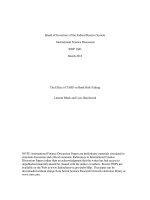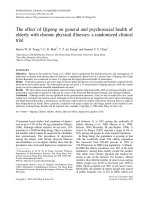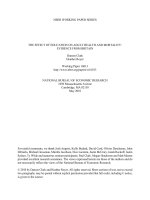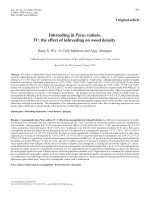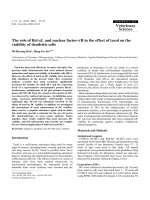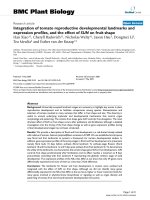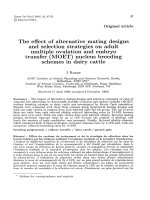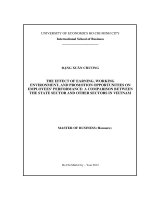The effect of weathering on wood and its protection
Bạn đang xem bản rút gọn của tài liệu. Xem và tải ngay bản đầy đủ của tài liệu tại đây (344.68 KB, 10 trang )
Forest Industry
THE EFFECT OF WEATHERING ON WOOD AND ITS PROTECTION
Trinh Hien Mai1, Tang Thi Kim Hong2, Nguyen Thi Yen1
1
Vietnam National University of Forestry
Nong Lam University – Ho Chi Minh City
2
SUMMARY
When wood and wood products is exposed outdoor, above ground, it undergoes many complex processes such
as: photo-degradation by ultraviolet and visible light; leaching, hydrolysis and swelling/shrinking by
water/moisture (railfall, dew, snow, changes in humidity in the air); discoloration by staining fungi and molds.
All of the above effects reduce the use and life-time of wood products. The appearance of unprotected wood
changes considerably after only few months of wood’s weathering exposure. To protect wood from deterioration
by weathering, the most common way is to prevent weathering factors from reaching the wood. Wood coatings
including paints, stains, and similar materials provide good protection to wood by partly or completely
obstructing the light to reach wood and excluding water from wood. Wood preservatives such as chromated
copper arsenate (CCA), ammoniacal copper quat (ACQ), acid copper chromate (ACC), mainly protect wood
from damages by microorganism. Chemical modification of wood may cause change in wood properties, hence
improve weathering resistance significantly. This paper discussed the influence of outdoor weathering including
photo degradation, water/moisture degradation and fungal degradation on the performance of wood in detail. The
chemical and physical changes of wood exposed outdoors are described, and methods for protecting exposed
wood surfaces are summarized.
Keywords: blue stain, outside weathering, photo-degradation, protection, water/moisture.
1. INTRODUCTION
Wood is a degradable natural polymer. The
degradation is considerably rapid when wood is
exposed outdoor without any protection. We see
many examples of effects of weathering on
wood. The rough, grey appearance of old barns,
wood shake roofs, and drift wood are typical
examples of weathered wood (Williams, 2005).
It has been widely established that sunlight
(UV, visible and IR light), moisture (dew, rain,
snow and humidity), organism (staining and
mold) are the most important causes, often
acting
simultaneously
for
weathering
degradation (Hon, 2001).
It is primarily the ultraviolet (UV) portion of
the solar spectrum that initiates the process we
refer to as weathering. It is a photo-oxidation or
photochemical degradation of the wood surface.
The degradation starts immediately after the
wood is exposed to sunlight. First, the color
changes, then the surface fibers loosen and
erode, but the process is rather slow. It can take
more than 100 years of weathering to decrease
the thickness of a board by 5 - 6 mm. In addition
to the slow erosion process, other processes also
occur. The wood may develop checks and a
118
raised grain. Mildew will colonize the surface
and discolor the wood. If boards contain
compression or juvenile wood, cross-grain
cracking may develop. The boards may warp
and cup, particularly in decking applications.
These other weathering factors such as mildew
growth, checking, splitting, and warping, are
often more important than the photo-oxidation
(Williams, 2005).
2. DEGRADATION OF WEATHERING
WOOD
2.1. Photodegradation
Solar irradiation (particularly UV, but also
visible light) is the most devastating component
in degrading wood by physical and chemical
actions during external weathering. UV light
can penetrate into wood to a depth of
approximately 75 µm and visible light
approximately 200 µm. In the electromagnetic
spectrum, UV light with wavelength between
295 and 400 nm is the most effective to
contribute to weathering (Hon, 1981,
Derbyshine and Miller, 1981). The degradation
process is initiated by the formation of free
radicals due to light absorption by wood
polymers. Lignin is a good light absorber
JOURNAL OF FORESTRY SCIENCE AND TECHNOLOGY NO. 11 (2021)
Forest Industry
having a broad absorption band in UV and
visible region (Hon, 1994). The light absorbing
abilities of cellulose and hemicellulose are
significant weaker than lignin. Lignin
contributes with 80 - 95%, carbonhydrates with
5 - 20% and extractive with about 2% to the
total UV absorption of wood (Norrström, 1969).
The consequences of photochemical reactions
on wood surfaces are loss of methoxyl content
of lignin, photo-dissociation of carbon-carbon
bonds and formation of carbonyl based
chromophoric groups. Phenolic hydroxyl
groups in lignin react with light rapidly to
produce phenolic radical, which in turn
transforms into o- and p-quinonoide structures
by demethylation or by cleavage of the side
chain and formation of colored unsaturated
carbonyl based chromophoric groups resulting
in the color change, and yellowing of wood
surface (Hon, 2001).
Pandey (2005) reported the results of
degradation of wood surfaces of Pinus
roxburghii (chir pine,) by an UV visible xenon
source. The changes in color of wood surfaces
were analyzed and correlated with lignin decay
and carbonyl formation estimated using FTIR
and fluorescence measurements. FTIR spectra
of P. roxburghii irradiated for different periods
are shown in Figure 1.
Figure 1. FTIR spectra of P. roxburghii irradiated for: (a) 0 hour, (b) 20 hours,
(c) 50 hours, (d) 100 hours and (e) 300 hours (Pandey 2005)
A comparison of spectra of exposed and
unexposed wood showed significant decrease in
the intensity of lignin aromatic absorption band
at 1511 cm-1, which is accompanied by a
successive increase in the intensity of carbonyl
absorption at 1734 cm-1. The intensities of peaks
associated with carbohydrates are not
significantly affected by irradiation. The rate of
lignin decay was calculated by determining the
ratio of lignin reference band at 1511 cm-1
against carbohydrate reference bands at 1375
and 1158 cm-1. Since photo-degradation has no
significant effect on the intensity of
carbohydrate peaks, these carbohydrate bands
were used as internal reference for calculating
lignin decay due to light irradiation. Similarly
the relative increase in the proportion of
carbonyl groups during irradiation was
calculated by taking ratio of intensity of
carbonyl band at 1734 cm-1 against
carbohydrate
reference
peaks.
The
lignin/carbohydrate ratio was reduced and the
ratio of carbonyl/carbohydrate was increased
when exposure time was increased from 0300h.
The color changes at wood surfaces are
mainly due to the formation of carbonyl (C=O)
groups due to photo-degradation of lignin. The
color changes of wood during light irradiation
were correlated very well with the lignin decay
JOURNAL OF FORESTRY SCIENCE AND TECHNOLOGY NO. 11 (2021)
119
Forest Industry
and formation of carbonyl groups generated
during photo-degradation of wood. Therefore,
the degree of photo-degradation of wood
surfaces can be assessed by fluorescence
measurements directly from wood surfaces.
Estimation of changes in chemical composition
of wood surfaces due to photo-degradation can
be carried out by measuring CIELAB
parameters (Pandey, 2005, Petrillo et al., 2019).
Hon (1994) used Southern yellow pine
(Pinus spp.) to study the effect of UV light and
acid rain on wood component. Wood specimens
(from earlywood) were microtomed into a thin
section with dimensions of 12 mm x 45 mm x
10 µm. Since wood is susceptible to UV
degradation, an increase in carbonyl groups,
based on the calculation using the FTIR relative
absorption peak ratio of 1,735 cm-1/895 cm-1,
was observed when wood specimens were
irradiated with UV light (without acid) at
ambient temperature. Thus, when wood
surfaces were exposed to UV light, carbonyl
group content increased and lignin content
decreased simultaneously (similar to Pandey’s
results). These changes were accelerated when
they were also exposed to a dilute sulfuric acid
solution-a laboratory simulation of acid rain
especially at 65°C and 65% relative humidity.
The higher concentrations of acid, the more
carbonyl groups were detected. Cellulose and
hemicelluloses are more susceptible to acid
reaction than lignin.
Evans (1988) used weight loss to assess the
deterioration of thin wood veneers during
weathering. It is indicated that significant
weight losses resulting from degradation of the
lignocellulosic matrix rather than from losses of
water soluble extractives occurred during
exposure. The high weight losses of thin
veneers after weathering appeared to result from
extensive breakdown of the ligno cellulosic
matrix. The increasing isolation of hexose
sugars following aqueous extraction may result
from depolymerization of cellulose or
hemicellulose. Lignin in accord with previous
observations of the chemical changes in wood
120
during natural weathering appeared to be
rapidly degraded during exterior exposure.
In a later work by Evans et al. (1996),
Radiata pine veneers and blocks were exposed
to natural weathering under Australian summer
conditions over a period of 30 days. Infrared
spectroscopy revealed that there was
perceptible surface delignification after 4 hours
exposure, substantial surface delignification
after 3 days exposure and almost complete
surface delignification after 6 days. Rapid lignin
degradation
was
also
suggested
by
measurements of the acid insoluble lignin
content of weathered veneers. Viscometry
determinations on holocellulose samples from
weathered veneers and unweathered controls
indicated significant depolymerisation of
cellulose after 4 days exposure.
In another research, Evans et al. (2007)
indicated that wood exposed to the weathering
increases the checking. Check numbers and
dimensions were greater in samples exposed to
the full solar spectrum than in samples exposed
under filters that blocked the transmission of
UV, visible or infra-red radiation. Samples that
were shielded from more energetic wavelengths
developed less checking. Checks developed in
the rays and propagated at the interface between
adjacent tracheids, close to the middle lamella.
Their findings also suggested that waterrepellent treatments designed to prevent wood
exposed outdoors from checking should contain
additives
that
restrict
the
surface
photodegradation of wood.
2.2 Water/moisture degradation
Wood exposed to the weather undergoes
degradation due to the effects of light and water.
Water plays an important role in weathering
since cyclic changes in moisture content
generate stresses leading to checking and
splitting. Water may also accelerate surface
degradation by leaching products of
photodegradation and loss in strength of wood
strips during weathering (Evans and Banks,
1988; Sudiyani et al., 1999).
The deterioration of wood is closely related
JOURNAL OF FORESTRY SCIENCE AND TECHNOLOGY NO. 11 (2021)
Forest Industry
to water/moisture. The change of wood
moisture content often results in swelling or
shrinking of wood. Such dimensional
movement in the wood is anisotropic, thereby
causing micro-checking. These micro-checking
can be gradually enlarge by the freezing and
thawing of absorbed water in the checking.
When the rich lignin-middle lamellas are
degraded (the photo degradation occurs
preferentially in this area of wood) and the
degraded fragments are subsequently removed
by water, the wood cell will de-bonded each
other. One these loose cells are removed by
water, the fresh layer of wood underneath will
be exposed to weathering (Xie, 2005). Because
latewood is denser, harder, smother, and darker
in earlywood, and its cells have thicker walls
and smaller cavities, the weathering process
yields more erosion in earlywood than that in
latewood (Williams, 2005). Weathering
deterioration of earlywood and latewood is
shown in Figure 2. Figure 3 describes a
mechanism enhancing light scattering in lignin.
Figure 2. Mechanical breakdown of wood exposed to solar irradiation (Xie, 2005)
Figure 3. Schematic description of mechanism by which enhanced light scattering in a lignindepleted, friable surface layer (1 to 2 mm) of weathered wood can protect the underlying lignincontaining wood from exposure to UV light. The curved tan line low in the drawing is meant to
suggest an annual ring (latewood) (Kropat et al., 2020)
JOURNAL OF FORESTRY SCIENCE AND TECHNOLOGY NO. 11 (2021)
121
Forest Industry
In the study of Sudiyani et al. (1999), the
lignin content in the albizzia wood surface
decreased significantly after exposure to
various weathering conditions, especially in the
presence of water irrespective of natural or
artificial conditions. Xylose, which was a main
component of hardwood hemicellulose xylan,
showed the same reduction tendency after
weathering. The major effect of weathering on
wood surfaces was delignification, and lignin
and hemicelluloses were easily decomposed by
UV irradiation. Cellulose was assumed to be
protected from photodegradation because
coexisting lignin preferentially absorbed UV
light and prevented cellulose from being
activated by UV. However, the chemical
composition of wood after natural weathering
without rainfall demonstrated that the action of
water was not negligible, as seen by the
decreased lignin and hemicellulose contents. It
was assumed that UV irradiation of wood
surfaces decomposed lignin and formed lowmolecular-weight lignin fragments, which
would be water-soluble. Water flashing would
leach away the lignin fragments together with
hemicelluloses as water-soluble lignocellulosic
materials. Therefore, the wood surfaces became
rich in cellulose, which was confirmed by the
increased relative content of glucose after
natural and artificial weathering. On the other
hand, the lignin content of sugi wood did not
decrease as markedly as was observed in
albizzia wood. Lignin and mannose contents
were significantly changed by weathering
conditions. The decreased mannose content
revealed a reduction of hemicellulose content in
the exposed wood because glucomannan is a
major component of hemicellulose in softwood.
The relatively increased glucose content
suggested that cellulose was kept on the wood
surfaces even after being exposed to
weathering, as in albizzia wood. The chemical
analysis for both wood species showed an
acceleration effect by water flashing on the
reduction of lignin and hemicellulose contents.
It was noteworthy that there was a marked
122
difference in the resistance against water during
weathering between albizzia and sugi; sugi
wood was more resistant to lignin and
hemicellulose reductions. Aromatic units of
lignin in softwoods and hardwoods are
composed of guaiacyl and guaiacyl-syringyl,
respectively. The susceptibility to weathering
deterioration might be different for the two
lignin types, with sugi lignin not easily removed
during weathering because of side reactions
such as condensation. The changes in
hemicellulose
contents
suggested
that
hemicelluloses would be removed along with
lignin. Lignin and hemicellulose are present in
wood cell walls as a ligninhemicellulose matrix,
so lignin decomposition would accelerate the
loss of hemicelluloses in the matrix during
exposure to water.
Generally, deterioration of wood exposed to
weathering has been believed to be mainly due
to the decomposition of lignin in cell walls.
Water such as rainfall was thought to play an
important role, causing the formation of checks,
cracks, and new surfaces, which are then
exposed to UV irradiation during shrinking and
swelling. Consequently, the decomposed lignin
components would be easily leached out from
the cell walls accompanied by erosion and
discoloration (Sudiyani et al., 1999).
2.3. Fungal degradation
Fungi which cause discoloration and
disfigurement of wood in storage and in service
are generally described as staining fungi while
those that grow superficial on wood are called
molds. They are the most common
microorganism found on weathered wood.
These fungi do not decay wood, i.e. do not
degrade the wood cell wall cellulose, do not
reduce the strength of wood to any significant
degree but they may increase the permeability
of wood. However, the development of stain in
timber and the emergence of molds on its
surface are considered of great economic
importance to the timber and wood preserving
industries because of losses in commercial
quality of the product (Eaton and Hale, 1993).
JOURNAL OF FORESTRY SCIENCE AND TECHNOLOGY NO. 11 (2021)
Forest Industry
Moisture content is probably the most
important factor in determining the rate and
extent of sapstain/mold infection in wood. In
soft wood timber maintained in temperature
conditions, fungal colonization of wood with an
initial moisture content of 100 - 130% will take
placed. These fungi are early colonizers of
freshly felled timber. Their carbon source
requirements are met mainly by the soluble
sugars and starch in the wood cell lumens but
they also feed on breakdown products derived
from the decay activities of other organisms
(Eaton and Hale, 1993).
Sapstain of freshly felled timber: The mature
hyphae of sapstaining fungi are brown in color
but when wood is extensively colonized by
these fungi, the wood appear blue to black
because of light diffraction.
Blue stain in service: In contrast to sapstain,
the development of blue stain in service is
common in processed wood which takes up
moisture periodically. The typical appearance
of blue stain may take the form of patches of
black discoloration on the wood surface
sometimes erupting through paint films or clear
varnish. On wood exposed out door, the surface
rapidly takes on grey appearance which may
take longer in hardwood than softwood.
Molds on freshly felled wood: The
vegetative hyphae are usually hyaline and
utilize available starch and sugars in superficial
parenchyma tissue. The hyphae of molds are
colorless, so they do not discolor wood,
however the spores produced by molds discolor
wood surface. Molds are simply removed by
brushing or planning the wood surfaces
(Bowyer and Haygreen, 1996).
In the study of Oberhofnerová et al. (2017),
weathering characteristics of 9 softwoods and
hardwoods species (spruce, pine, Douglas fir,
larch, oak, black locust, maple, poplar and
alder) during twelve months of exposure in the
climatic conditions of Central Europe were
determined. The mould growth was first
observed at maple, poplar and alder samples
after the fourth month of weathering. After 6
months of weathering, wood samples (mostly
Douglas fir wood) showed formation of
numerous cracks which basically ran in the
direction of wood fibres. Mould and blue-stain
fungi growth was observed in those species that
are not durable against fungal attack (EN 3502: 1994) such as maple, poplar and alder
samples, especially after the fourth month of
exposure. Faster attack of biotic factors was
caused by higher mean temperature and the total
precipitation after the fourth month of
weathering.
3. WOOD PROTECTION AGAINST
WEATHERING PROCESS
Wood is readily degraded by weathering,
without any protection, the service life of the
weathering wood is considerably limited. To
protect wood from deterioration by weathering,
the most common way is to prevent weathering
factors from reaching the wood. The invasion of
microorganism may be reduced by treating
wood with preservatives. Wood coatings
provide good protection to wood by partly or
completely obstructing the light to reach wood
and excluding water from wood. Chemical
modification of wood may also cause change in
wood structure, improve weathering protection.
Therefore, the protecting strategies are
categorized into three parts:
3.1. Wood preservatives
Wood preservatives mainly protect wood
from damages by microorganism. The common
wood preservatives can be divided into two
groups: oil-borne preservatives such as creosote
and
water-borne
preservatives.
Under
environmental pressure, more water-borne
preservatives
are
developed,
mainly
preservatives containing copper, such as
chromated copper arsenate (CCA), ammoniacal
copper quat (ACQ), acid copper chromate
(ACC), etc (Xie, 2005).
Feist and Williams (1991) reported the
efficiency of CCA and chromium trioxide
treatments in decreasing the effect of
weathering of unfinished Sounthern pine wood
and improving the durability of semitransparent
JOURNAL OF FORESTRY SCIENCE AND TECHNOLOGY NO. 11 (2021)
123
Forest Industry
and solid-color stains applied to the treated
wood. Unfinished and finished southern pine
sapwood specimens treated with either CCA or
chromium trioxide were exposed to accelerated
weathering. Small amounts of chromium salts
on the wood surface greatly decreased erosion
of the wood caused by ultraviolet-lightcatalyzed degradation. Pressure treatment with
CCA provided long-term protection against
erosion for unfinished wood. Treatment of the
wood surface with a brush-applied solution of
chromium trioxide also decreased erosion but
lower than the wood treated with CCA. The
CCA treatment penetrated the wood and
deposited more chromium at the surface than
did the chromium trioxide surface treatment.
The study of Altay et al. (2020) was aimed
to investigate the effects of weathering on some
surface characteristics such as color and surface
roughness changes of Scots pine impregnated
with copper-containing chemical such as
Wolmanit CX-8 (WCX-8), varnished with
synthetic varnish (SV), cellulosic varnish (CV),
and polyurethane varnish (PV) were
investigated. Results showed that while the
WCX-8 impregnated and PV coated Scots pine
specimens showed better color stability than
other treatment groups after weathering, only
CV coated Scots pine gave the most negative
effect on color stability. While, the untreated
(control) wood surface turned from red to green
and yellow to blue respectively, after
weathering, other all treatment groups gave
reddish and yellowish tone after weathering.
Weathering conditions increased the surface
roughness of control (untreated) and other all
treatment groups. The control group gave a
rougher surface than other treatment groups
after weathering. Surface roughness increases
were the lower for CV coated Scots pine wood
than other treatment groups. The results showed
that while WCX-8 impregnation before
varnishing gave better color characteristics,
generally it caused to increase the surface
roughness of Scots pine after weathering.
Water repellent preservatives give slight
124
protection during early stage of the weathering
by decreasing the amount of degradation
products washed from the surface. In addition,
they also increase the resistance to the attack of
fungi (Williams, 2005).
3.2. Paint and stains
Wood exposed to the weather can be
protected by paints, stains, and similar
materials. Paints provide the most protection
because they are generally opaque to the
degradative effects of UV light and protect
wood to varying degrees against water. Paint
performance may vary greatly on different
woods. Pigmented stains also provide durable
finishes (Feist, 1990).
Weathering of wood gives surface which can
not hold paint very well, but the weathered
surface can accept penetrating stain extremely
well (Williams, 2005). Evans et al. (1996) used
a tape test to assess the adhesion of acrylic latex
primers to weathered blocks. The adhesion of
exterior acrylic primers decreased on weathered
wood surfaces and was significantly lower on
specimens that were weathered for 5 to 10 days.
An oil-modified acrylic primer showed greater
adhesion to weathered wood surfaces.
Semitransparent stain on southern pine
pressure treated with CCA had longer service
life than similar wood treated with brushapplied chromic acid prior to staining (Feist and
Williams, 1991). Clear finishes (urethane,
expoxides, etc) do not work outside because
they do not protect against UV, therefore the
wood under the finish is deteriorated. When the
finish cracks, moisture easily moves in, molds
and stain start growing (Goodell, 2007).
A properly applied paint system gives the
greatest protection to wood surface against UV
radiation. The pigments in the paint block the
UV radiation and the paint film retards water
absorption. The less pigment a stain or paint has
in it, the less UV protection will be provided
(Goodell, 2007).
3.3. Chemical modification
Chemical modification of wood aims at
enhancing various wood properties such as
JOURNAL OF FORESTRY SCIENCE AND TECHNOLOGY NO. 11 (2021)
Forest Industry
durability, moisture sorption, dimensional
stability, strength and hardness. Moreover, it
imparts stability towards UV-radiation,
improvement of weathering performance and
reduction of flammability. Various types of
chemical compounds have been used for the
modification of wood including anhydrides, acid
chlorides, carboxylic acids, isocyanates,
aldehydes, alkyl chlorides, lactones, nitriles and
epoxides (Rowell, 2005). The chemicals may fill
in the cell lumen, cell wall or have reaction with
abundant hydroxyl groups of lignin, cellulose,
hemicellulose in the cell wall. The cell wall
modification made the wood dimensionally
stable and restricts check and warp, the lumen fill
help hold degradation product in place, thus
significant improving UV resistance.
Feist et al. (1991) reported that the erosion of
accelerated weathering of the wood cell-wall
modification with acetic anhydride, lumen fill
with methyl methacrylate, and a combination of
these two treatments was reduced from 40 to
85% compared to that of untreated wood
(aspen). Chemical analysis before and after
accelerated weathering showed that ultraviolet
degradation caused a large loss of surface lignin
and xylose (from xylans) in control specimens.
Both acetylation and methacrylate treatments,
or a combination of these two, reduced the loss
of surface lignin with subsequent reduction in
weathering. Acetylation, especially at 18
weight-percent gain, reduced the loss of xylans
during accelerated weathering.
At the condition of natural weathering, the
treatment
with
dimethylol
dihydroxyethyleneurea (DMDHEU) reduced
discoloration and crack of wood surface, and
prevented surface erosion in particular on the
area of earlywood compared to untreated wood
(Scots pine). The fungi on the panels treated
with DMDHEU grew less than in untreated
panels after outdoor weathering. FTIR
evidences revealed that wood treated with
DMDHEU did not long-term protect lignin
from weathering degradation (Xie, 2005; Xie et
al., 2008; Pfeffer et al., 2012).
Rapp and Peek (1999) treated Scots pine
sapwood (Pinus sylvestris L.), Norway spruce
(Picea abies L.), English oak heartwood
(Quercus robur L.) and Douglas fir heartwood
(Pseudotsuga
menziesii
France.)
with
melamine resin or coated with varnish, and
exposed them to natural weathering without
ground contact for two years. The melamine
resin, even in low concentrations provided
distinctive protection against photochemical
wood degradation by weathering and infestation
by wood staining fungi, but did not protect
wood against cracking and moisture.
Beech (Fagus sylvatica L.) veneers were
treated with two formulations based on Nmethylol-melamine (NMM): (1) NMM solution
(NMM-1, 10% solid content), (2) fatty acid
modified NMM dispersions containing paraffin
(with an aluminium salt as catalyst, mNMM-2,
5% solid content). Five veneers were glued with
a phenol formaldehyde adhesive to produce
plywood. The plywood specimens were
weathered outdoors over a period of 18 months
according to EN 927-3. The treatment of
veneers with NMM-1 and mNMM-2 improved
the weathering performance of plywood
produced thereof as compared to those from
control veneers. The treatments reduced
discoloration and fungal staining as well as
cracking, deformation and discoloration of
uncoated and coated plywood panels during 18
months outdoor weathering conditions. These
effects are mainly attributable to the reduction
in water uptake, which increases dimensional
stability (Trinh et al., 2012). The similar results
were found in the study of Nguyen et al. (2007)
for Beech (Fagus sylvatica L.) wood.
Grinins et al. (2021) investigated the effect
of phenol-formaldehyde (PF) resin treatment on
the weathering stability and biological
durability of birch plywood. Silver birch
(Betula pendula) veneers were vacuumpressure impregnated with four different PF
resins with average molecular weights (Mw) of
292 (resin A), 528 (resin B), 703 (resin C), and
884 g/mol (resin D). The aging properties of PF
JOURNAL OF FORESTRY SCIENCE AND TECHNOLOGY NO. 11 (2021)
125
Forest Industry
resin modified birch plywood were analyzed
using artificial weathering with ultraviolet (UV)
light, UV and water spray, and weathering
under outdoor conditions. It was not possible to
compare weathering processes under artificial
conditions to processes under outdoor
conditions. However, the weathering stability of
birch plywood treated with PF resins A, B, and
C, scored better than plywood treated with
commercial resin D (regardless of solid content
concentration [%]).
4. CONCLUSIONS
The middle lamella between the wood cells
has a higher lignin content than the cell wall and
degrades faster than the cell wall. The αcarbonyl sites in the lignin have been shown to
be quite labile to absorption of UV radiation.
The formation of free radicals initiates a series
of oxidative degradation reaction. The crosslink density of lignin decreases, resulting in loss
of lignin. Water plays a crucial role in washing
the degradation products from the surface,
leaching hemicelluloses, abrading the surface,
and causing checking. It is also generally
accepted that mold (mildew) such as
Aureobasidium pullulans, the most common
microorganism found on weathered wood, does
not have the enzymes to degrade lignin or
polysaccharides. Molds cause more appearance
problems than actual degradation of wood;
however, aggressive cleaning methods to
remove them using strong chemicals and/or
power-washing can greatly accelerate the loss
of wood fiber from wood surfaces.
Much research has been done to reduce the
photochemical degradation caused by UV
radiation and water during weathering. There is
considerable going on study to develop new
stabilizers, such as hindered amine light
stabilizers (HALS) which serves as free radical
scavenger to trap the free radicals, thus reducing
the risk of free radical degradation.
REFERENCES
1. Altay, C., Baysal, E., Toker, H., Turkoglu, T.,
Kucuktuvek, M., Gunduz, A., Peker, H. (2020) ‘’Effect of
natural weathering on surface characteristics of Scots
pine impregnated with Wolmanit CX-8 and varnished’’,
126
Wood Research, 65(1): 87.
2. Bowyer, J. L and Haygreen, J. G (1996), ‘’Forest
Products and Wood science: an Introduction’’, Third
Edition, Wiley-Blackwell Publisher.
3. Derbyshire, H., Miller, E R. (1981), “The
photodegradation of wood during solar irradiation”,
Part 1. Effects on the structural integrity of thin wood
strips. Holz Roh-Werkstoff 39: 341.
4. Evans, P. (1988), "A note on assessing the
deterioration of thin wood veneers during weathering",
Wood and Fiber Science 20(4): 487.
5. Evans, P. and W. Banks (1988), "Degradation of
wood surfaces by water changes in mechanical properties of
thin wood strips", Holz als Roh- und Werkstoff 46(11): 427.
6. Evans, P. a. K. U. (2007), "The effect of solar radiation
on the surface checking of wood", IRG/WP 07-40356.
7. Evans, P. D., P. D. Thay, et al. (1996),
"Degradation of wood surfaces during natural
weathering. Effects on lignin and cellulose and on the
adhesion of acrylic latex primers" , Wood Science and
Technology 30(6): 411.
8. Eaton, R.A. and Hale, M. D. C. (1993), ‘’Wood:
decay, pest and protection’’, Chapman & Hall, London.
9. Feist, W. C. and Williams, R. S. (1991),
"Weathering durability of chromium-treated southern
pine", Forest products 41(1): 8.
10. Feist, W. C, (1990), Chapter 11 ‘Outdoor Wood
Weathering and Protection’, In: ‘Archaeological Wood Properties, chemistry, and preservation’. Edit by Rowell
R.M. and Barbour. R. J., American Chemical Society:
263-298.
11. Feist, W. C., Rowell, R. M., Ellis, W. D. (1991),
"Moisture sorption and accelerated weathering of
acetylated and methacrylated aspen", Wood and Fiber
Science 23(1): 128.
12. Goodell, B. (2007), Lectures on Wood
degradation and Wood deterioration for Tropical
International Forest Program, University of Göttingen,
Germany.
13. Grinins, J., Biziks, V., Marais, B. N., Rizikovs, J.,
& Militz, H. (2021), "Weathering stability and durability
of birch plywood modified with different molecular
weight phenol-formaldehyde oligomers", Polymers,
13(2):175.
14. Hon, DN-S (1981),“Photochemical degradation
of lignocellulosic materials” In: Developments in
Polymer Degradation. Ed.N. Grassi. Appl Sci Publ,
London.
15. Hon, DN-S (1994), "Degradative effects of
ultraviolet light and acid rain on wood surface quality"
Wood and Fiber Science 26(2):185.
16. Hon, DN-S (2001), "Weathering and
photochemistry of wood", In: Wood and Cellulosic
Chemistry, Second edition, revised and expanded,
Edited by Hon DN-S and Nobuo Shiraishi, Marcel
Dekker: 513-546.
JOURNAL OF FORESTRY SCIENCE AND TECHNOLOGY NO. 11 (2021)
Forest Industry
17. Kropat, M., Hubbe, M.A., and Laleicke, F. (2020),
''Natural, accelerated, and simulated weathering of
wood: A review'', BioResources 15(4): 9998-10062.
18. Norrström, H. (1969), "Light absorbing properties of
pulp and paper components" svensk Paperstidn 72: 25-38.
19.
Nguyen, H., M., Militz, H., Mai, C. (2007),
‘’Weathering properties of wood modified with
hydrophobation agents’’, Proceeding of European
Conference on Wood Modification 2007: 205-208.
20. Oberhofnerová, E., Pánek, M., Cimarras, A-G.,
(2017), ''The effect of natural weathering on untreated
wood surface'', Maderas. Ciencia y tecnología 19(2): 173.
21. Pandey, K. K. (2005), "Correlation between
changes in colour and chemical composition during photodegradation of wood surfaces". IRG/WP 05-40301.
22. Petrillo, M., Sandak, J., Grossi1, P. and Sandak,
A. (2019), ''Chemical and appearance changes of wood
due to artificial weathering – Dose–response model'',
Journal of Near Infrared Spectroscopy, Vol. 27(1): 26.
23. Pfeffer, A., Militz, H., Mai, C. (2012),
‘’Weathering characteristics of wood treated with water
glass, siloxane or DMDHEU’’, European Journal of
Wood Products 70: 165.
24. Rowell, R. M. (2005), Chapter 14: Chemical
modification of wood, In: Hand book of wood chemistry
and wood composites, Edited by Rowell R.M., First
edition, CRC Press: 381-420.
25. Rapp, A. O., Peek, R. D. (1999),
''Melaminharzimprägniertes sowie mit Wetterschutzlasur
oberflächenbehandeltes und unbehandeltes Vollholz
während zweijähriger Freilandbewitterung'', European
Journal of Wood and Wood Products 57(5): 331.
26. Sudiyani, Y., Tsujiyama S., Imamura Y.,
Takahashi M., Minato K. and Kajita H. (1999),
"Chemical characteristics of surfaces of hardwood and
softwood deteriorated by weathering" Journal of Wood
Science 45(4): 348.
27. Trinh, H. M., Militz, H., Mai, C. (2012),
''Modification of beech veneers with N-methylol
melamine compounds for the production of plywood:
natural weathering'', European Journal of Wood Products
70: 279.
28. Williams, R. S. (2005), Chapter 7: Weathering of
wood, In: Hand book of wood chemistry and wood
composites, Edited by Rowell R.M., First edition, CRC
Press: 139-185.
29. Xie, Y. (2005), Doctoral thesis: ‘Surface
properties of wood modified with Cyclic N – methylol
compound’, University of Göttingen, Germany.
30. Xie, Y., Krause, A., Militz, H., Mai, C. (2008),
''Weathering of uncoated and coated wood
treatedwithmethylated
1,3-dimethylol-4,5dihydroxyethyleneurea(mDMDHEU)'', Holz Roh Werkst
66: 455.
ẢNH HƯỞNG CỦA CÁC YẾU TỐ THỜI TIẾT ĐẾN GỖ
VÀ CÁC BIỆN PHÁP BẢO VỆ GỖ
Trịnh Hiền Mai1, Tăng Thị Kim Hồng2, Nguyễn Thị Yên1
1
2
Trường Đại học Lâm nghiệp
Trường Đại học Nơng Lâm – TP. Hồ Chí Minh
TÓM TẮT
Khi gỗ và các sản phẩm từ gỗ được sử dụng ngoài trời, trên mặt đất, các sản phẩm này chịu ảnh hưởng đồng thời
của nhiều yếu tố môi trường như: q trình quang hóa gây ra bởi ánh sáng mặt trời; q trình thuỷ phân, bào
mịn, trương nở và co rút gây ra bởi các yếu tố thuộc về nước/độ ẩm (nước mưa, sương, tuyết và thay đổi độ ẩm
trong khơng khí); q trình biến màu gây ra bởi sự xâm nhập của các loại nấm... Tất cả những ảnh hưởng trên
làm giảm khả năng và thời gian sử dụng của sản phẩm gỗ. Bề mặt của gỗ thay đổi đáng kể chỉ sau vài tháng sử
dụng ngoài trời. Do đó, để giảm các tác động của mơi trường ngoài trời đến gỗ và các sản phẩm từ gỗ, biện pháp
phổ biến nhất là ngăn cách bề mặt gỗ với môi trường như sơn phủ bề mặt. Các chất bảo quả như chromated
copper arsenate (CCA), ammoniacal copper quat (ACQ), acid copper chromate (ACC) có khả năng bảo vệ gỗ
khỏi các tác nhân sinh học. Bên cạnh đó, các giải pháp biến tính gỗ, làm thay đổi cấu trúc tế bào gỗ, đã và đang
được nghiên cứu, đã chỉ ra nhiều kết quả khả quan cho việc nâng cao khả năng chống chịu các điều kiện môi
trường cho gỗ và các sản phẩm từ gỗ biến tính. Bài báo này thảo luận chi tiết ảnh hưởng của các yếu tố mơi
trường ngồi trời đến gỗ bao gồm những thay đổi về vật lý và hóa học của gỗ, đồng thời các biện pháp bảo vệ gỗ
khi sử dụng ngoài trời cũng được trình bày ở đây.
Từ khóa: bảo vệ, nấm biến màu, nước/độ ẩm, quang hóa, thời tiết ngồi trời.
Received
Revised
Accepted
: 05/6/2021
: 07/7/2021
: 26/7/2021
JOURNAL OF FORESTRY SCIENCE AND TECHNOLOGY NO. 11 (2021)
127
